 Gardeners successfully grow cucumbers not only in greenhouses, but also in open-air beds. Providing the plants with proper care and comfortable conditions, you can count on getting an excellent crop of greenhouses.
Gardeners successfully grow cucumbers not only in greenhouses, but also in open-air beds. Providing the plants with proper care and comfortable conditions, you can count on getting an excellent crop of greenhouses.
Regular watering, timely top-dressing, the use of covering materials in inclement weather - knowledge of the nuances of agricultural crop technology will allow you to remove cucumbers from the beds with buckets.
Content
- 1 Seat selection
- 2 Warm beds
- 3 Secrets of proper watering
- 4 We strengthen the root system
- 5 Top dressing: the basic rules for growing cucumbers
- 6 Cucumber formation
- 7 Open Ridge Cucumber Garter
- 8 What to do if cucumbers are not pollinated
- 9 Disease protection
- 10 Protection of cucumbers in the garden from pests
- 11 Picking a crop
- 12 Useful tips for increasing the yield of cucumbers
Seat selection
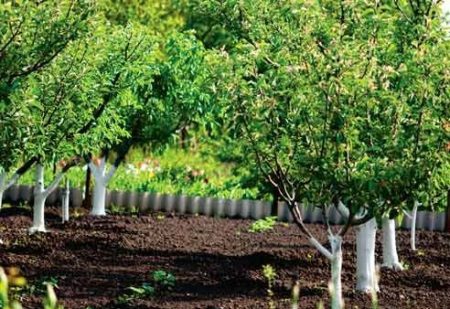 The culture has strict requirements for soil fertility; it works better on chernozems, light loam, sandy loam soil.
The culture has strict requirements for soil fertility; it works better on chernozems, light loam, sandy loam soil.
The beds are placed in a sunny, well-warmed place area where there is no stagnant moisture and the proximity of groundwater.
Take into account the climatic features of the region:
- in the middle lane, regions of the North-West, suitable places are sites on the southern slopes, protected from winds and precipitation;
- in the south - flat places, a slight shadow is acceptable, while protection from the withering winds is also important.
Cucumbers grow best after legumes, onions and leeks, garlic, celery, potatoes, tomatoes. Crop rotation is mandatory, the culture does not like to grow on the same ridge every year.
Warm beds
Heat-loving plants in the open air need to provide heat, adequate nutrition, moisture. An effective way to grow crops is to create warm beds, and it is recommended to do them from the fall.
In the middle of the ridge, a trench is dug up to a depth of 40 cm, a width of 80-100 cm. Manure and plant debris from the ridges (plant tops, weeds) are laid in layers, sprinkling the contents with a small amount of lime. From above, everyone is covered with earth.
In the spring, as soon as the snow melts and the heat comes, the remains laid in the trench will begin to decay. In the process of decay, heat so needed by cucumbers is released, as well as a large amount of carbon dioxide, necessary for photosynthesis.
The garden is dug up, covered with a black film for heating, and then seedlings of cucumbers are planted.
When digging make complex fertilizers (nitrophos), ash.
Cucumber seedlings are planted on warm ridges, seeds are sown (in the southern regions).
Secrets of proper watering
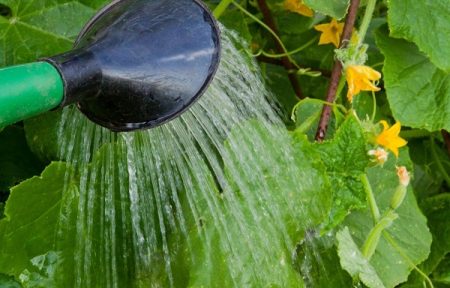 Cucumbers love moisture, for the normal growth of greenery and green mass, constant moistening of the soil is necessary. At the same time, excess moisture inhibits plants, slows down the formation of new shoots and fruits, and reduces the amount of oxygen in the soil.
Cucumbers love moisture, for the normal growth of greenery and green mass, constant moistening of the soil is necessary. At the same time, excess moisture inhibits plants, slows down the formation of new shoots and fruits, and reduces the amount of oxygen in the soil.
Regardless of the characteristics of the variety, cucumbers provide regular timely watering. For plants in open ridges, good help is rainwater, which contains more nutrients and oxygen than well and tap water.
The watering schedule varies, as many factors are taken into account:
- weather;
- growing season;
- plant condition;
- type and condition of soil.
Usually in the summer season, cucumbers are watered from 3 to 5-6 times a week, while feeding the bushes. It is watered every day in the heat, on rainy days the plants receive enough moisture from the rain.
Watering by vegetation period:
- during the growth of green mass, watering every 4-5 days, 3-4 liters for each bush;
- during flowering - 4-6 liters as the soil dries up;
- in the period of fruit return - 8-10 liters per bush.
For watering, it is advisable to make small grooves next to the plants. This will protect the soil from erosion, and plant roots from exposure.
Watered cucumbers previously defended warm water, temperature + 22ºC ... + 24ºC. Water from a well, well, spring, pond must be defended in barrels, tanks, heated and only then used for irrigation.
In the period of prolonged rains, the state of plants is controlled, the level of moisture in the soil, preventing rotting of the stems and leaves of cucumbers. If necessary, make small grooves for drainage so that water quickly leaves the ridges. A good effect is given by drip irrigation systems when moisture evenly flows to the roots of plants and there is no overmoistening.
We strengthen the root system
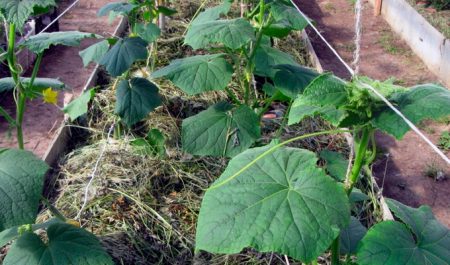 Cucumbers have a superficial root system located at a depth of up to a maximum of 25-30 cm. The main part of the roots is in the upper soil layer, at a depth of about 5-6 cm.
Cucumbers have a superficial root system located at a depth of up to a maximum of 25-30 cm. The main part of the roots is in the upper soil layer, at a depth of about 5-6 cm.
The roots are poorly developed, in volume they make up only 1.5-2% of the total total mass of the bush. In order for the plant to bear fruit abundantly, it is necessary not only to provide nutrition, but also to strengthen the roots of cucumbers.
Two practices are practiced:
- hilling, when the ground is carefully sprinkled to the stem;
- sprinkling of a pressed cucumber stem on the ground.
This gives an impetus to the formation of additional roots, strengthens the root system of the plant, reduces the risk of root rot.
After watering, the soil is loosened, but very carefully so as not to touch and damage the roots. When loosening, the lashes are gently pushed back, not turned over and then returned to their original place.
An alternative to loosening is mulching, for which the soil is covered with sawdust, hay, straw, rotted manure or peat. Mulch retains moisture, prevents the formation of crusts, and prevents weeds from growing.
It is not recommended to use fresh grass for mulching, as this causes the appearance of rot on the stems of cucumbers.
Humus as a mulch additionally saturates the earth with nitrogen, improves soil aeration.
Top dressing: the basic rules for growing cucumbers
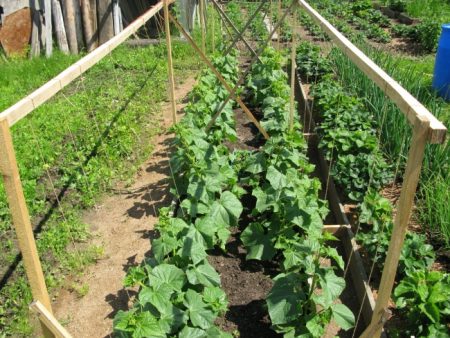 Harvesting cucumbers is impossible without providing a healthy diet. Even if the ridges were pre-seasoned with fertilizers (organic, mineral compounds), during the growing season the plants must be fed.
Harvesting cucumbers is impossible without providing a healthy diet. Even if the ridges were pre-seasoned with fertilizers (organic, mineral compounds), during the growing season the plants must be fed.
The total number of top dressings is at least 3-4 times, while the root “dinners” for plants alternate with spraying on the leaves. Foliar top dressing is effective in cold weather, when the roots absorb nutrients poorly and for a long time, and through the leaves the plant will quickly receive all the necessary elements.
- The first top dressing is a week after transplanting seedlings. Cucumbers are fed with diluted mullein (1:10) or urea (it is enough to take one tablespoon of fertilizer per bucket). The norm for the bush is 0.5 liters.
- After 8-10 days - the next top dressing: urea (10-15 grams), potassium sulfate (15 grams), superphosphate (50 grams) are diluted in ten liters of water.
- The same mixture is recommended to feed cucumbers during the flowering period.
- In the period of the beginning of fruiting and further, as the greens are harvested, top dressing is carried out once every 10 days, using potassium and nitrogen fertilizers.
- Urea solution is used for spraying during flowering: 15 grams of fertilizer are added to 10 liters of water. Cucumbers are processed early in the morning or in the late afternoon so that there are no burns on the leaves.
- During the flowering and fruiting period, green fertilizer is useful for cucumbers. 2/3 of the nettles are poured into the tank or barrel, dandelion, comfrey, pour water to the top, tightly close. Insist the contents for a week, mixing once every 2 days. Then diluted with water (1:10), watered cucumbers under the root. Top dressing promotes the growth of new shoots, the formation of ovaries, the rapid formation of greenhouses.
The appearance of cucumbers determines what nutrients the plant lacks or vice versa, an excess is observed.
Nitrogen deficiency
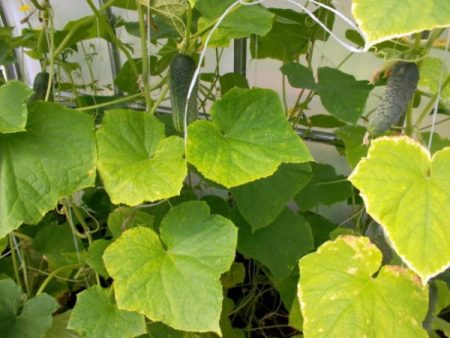 Plant growth slows down, the brightness of the leaves is lost. Shoots are thinned, greenbacks are shortened, leaf blades are reduced in size.
Plant growth slows down, the brightness of the leaves is lost. Shoots are thinned, greenbacks are shortened, leaf blades are reduced in size.
Mullein, urea are introduced.
Potassium deficiency
The main symptom: the appearance of yellow spots on the leaves, while the veins of the plates remain green. Magnesium deficiency affects the growth of plants, the slow formation of greenhouses.
They bring wood ash, potassium magnesia under cucumbers.
Potassium deficiency
A broad yellow border is formed on the old leaf blades, young leaves are crushed, the green leaves become bitter.
They bring wood ash, potassium sulfate, process the bushes along the leaves with a weak solution of potassium permanganate.
Phosphorus deficiency
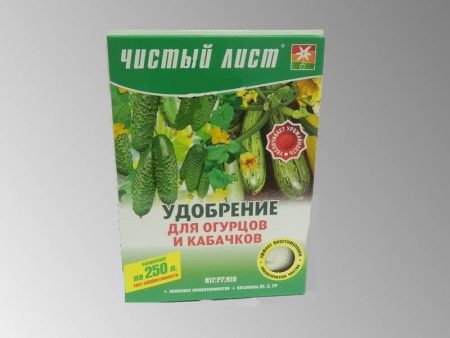 The disadvantage of this important element on plants is not immediately noticeable. The growth of cucumbers gradually slows down, leaf blades become dark green, dense, spots with watery contents appear on the surface.
The disadvantage of this important element on plants is not immediately noticeable. The growth of cucumbers gradually slows down, leaf blades become dark green, dense, spots with watery contents appear on the surface.
They bring in superphosphate (about 40 grams per 1 m2), any other potassium-phosphorus fertilizers (nitrophosphate).
To avoid starvation of cucumbers and a deficiency of macro- and microelements necessary for plants, it is recommended to feed seedlings and young bushes with special combined formulations. Among them:
- Agricola No. 5 (for zucchini, cucumbers and squash;
- Ideal;
- Master.
In adverse weather conditions, watering cucumbers under the root of humates gives a good effect:
- with prolonged rains, sodium humate is useful;
- in hot dry weather, potassium humate is used.
Humic preparations increase plant resistance to stress, do not accumulate in the soil, and are harmless to humans.
Cucumber formation
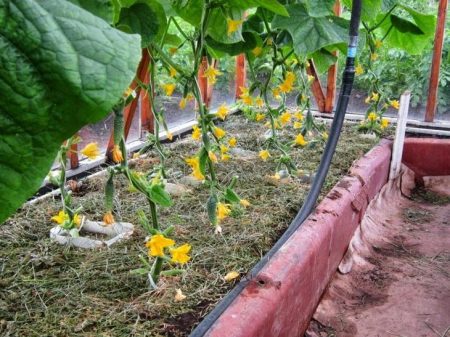 It was traditionally believed that they form (pinch) shoots only in cucumbers growing in a greenhouse. But to increase the number of ovaries of greenhouses, the plants in the garden are also nipped.
It was traditionally believed that they form (pinch) shoots only in cucumbers growing in a greenhouse. But to increase the number of ovaries of greenhouses, the plants in the garden are also nipped.
Lateral shoots take away nutrients from forming fruits, the plant spends a lot of energy in vain, therefore, it is recommended to pinch cucumber lashes on the garden.
When forming take into account:
- features of the variety, hybrid of cucumber;
- ripening dates.
Early ripe cucumbers do without pinching, for varieties of mid-ripening and yielding crops in late terms, reception is required.
Varietal cucumbers in the beds:
- pinch the main stem over a 5-6 leaf;
- pinch lateral shoots, reaching 20-25 cm.
Hybrids:
- along the entire length up to 50-60 cm of the height of the stem, all inflorescences, ovaries, and embryo shoots are removed;
- on a stem from 60 to 100 cm, only one leaf and ovary is left;
- above, up to 150-160 cm, two leaves and two ovaries are left.
Formation is necessary, as the crop of Zelentsy increases, the taste improves, and the risk of diseases appears. Without pinching, the stems creeping along the surface of the ridge are intertwined, and it is difficult to care for cucumbers.
Open Ridge Cucumber Garter
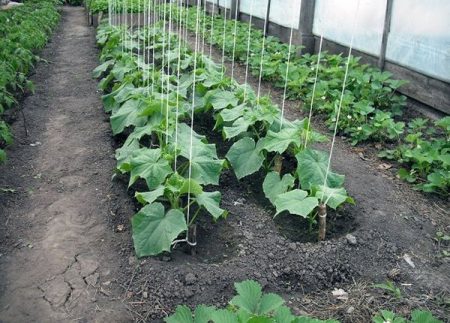 The topic of tying bushes in the garden is related to the issue of the formation of cucumbers. Some summer residents grow cucumbers in a spread, others believe that trellis is also required in the garden, as in a greenhouse.
The topic of tying bushes in the garden is related to the issue of the formation of cucumbers. Some summer residents grow cucumbers in a spread, others believe that trellis is also required in the garden, as in a greenhouse.
Indeed, tying cucumbers on the trellis gives its "pluses":
- lack of dampness;
- vertically tied bushes are evenly lit by the sun;
- plant ventilation improves;
- reduced risk of rot, bacteriosis;
- Zelentsy ripen faster;
the fruiting period of the culture is increasing.
The bed with trellises looks neat and beautiful, while the yield from such plantings is higher.
What to do if cucumbers are not pollinated
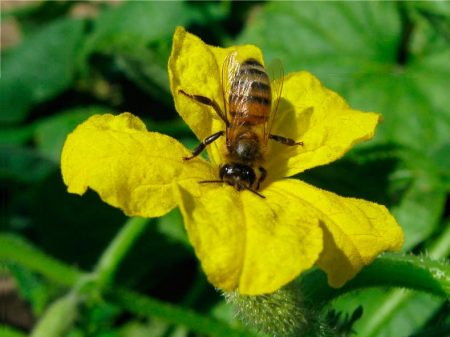 The problem arises in bee pollinated varieties when there are few bees in the area and the ovaries remain without pollination.As a result, the overall yield is reduced.
The problem arises in bee pollinated varieties when there are few bees in the area and the ovaries remain without pollination.As a result, the overall yield is reduced.
To correct the situation, artificial pollination will help, for which they use a regular brush. On the bushes at the time of flowering, female (with a small undeveloped fruit at the base) and male flowers are formed. For pollination, it is necessary that pollen from the stamens of male flowers fall on the female pestle, and transfer it with a brush.
If the process was successful, the fruit at the base of the flower will develop, turning into a full-fledged cucumber. For plants grown on trellises, a simpler option is suitable: shake the whips gently so that the pollen crumbles.
Disease protection
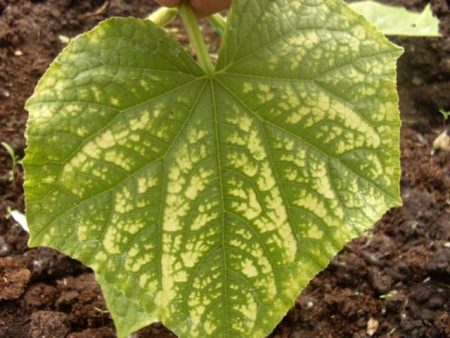 In order to prevent the appearance of infections on the bed, it is required to observe agricultural technology:
In order to prevent the appearance of infections on the bed, it is required to observe agricultural technology:
- do not exceed the dose of fertilizer;
- control soil moisture;
- pour cucumbers with warm water;
- plant seedlings taking into account the distances between the bushes.
The main diseases of cucumbers in the beds:
- anthracnose;
- root rot;
- powdery mildew.
Cool weather, prolonged rains, thickening of plants, a large number of weeds contribute to the manifestation of diseases.
Anthracnose
The main cause of infection is high humidity. The stems of the plants turn yellow and dry, yellow spots appear on the leaf blades. The formed cucumbers turn yellow, rotting pinkish spots form on the skin.
Help with such an infection should be provided promptly, for which they spray the bushes with Bordeaux liquid (1%).
Powdery mildew
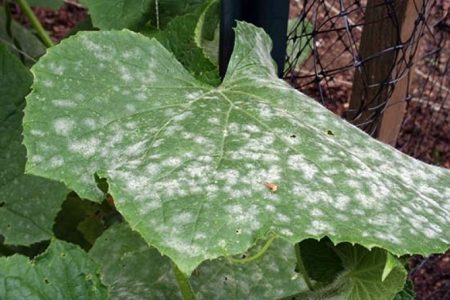 Reasons: high air humidity, heavy dew, cool temperature (below + 18ºC ... + 20ºC). Small whitish spots appear on the surface of leaf blades of plants, gradually covering the entire area of the leaf. The plant dries and dies.
Reasons: high air humidity, heavy dew, cool temperature (below + 18ºC ... + 20ºC). Small whitish spots appear on the surface of leaf blades of plants, gradually covering the entire area of the leaf. The plant dries and dies.
Heavily affected bushes are removed from the ridge, the rest are sprayed with special compounds:
- mullein infusion (1:10);
- Bordeaux liquid (1%);
- drugs Topaz, Jet (used according to the instructions);
- whey diluted in water (1:10).
Spray bushes on the upper leaves, as well as on the lower shoots.
Root rot
Reasons: the use of seeds infected with the infection, the presence of pathogens of the disease in the soil in the soil, temperature differences.
The leaves of cucumbers fade during the day, in the evening again restore elasticity. The stalk at the bottom becomes brown, then rots, turns into dust. The roots die, and after them the whole plant dies completely.
For treatment, treatment with Fitosporin-M, Effekton is used, Bactofit and copper-containing Hom are added to the soil.
Protection of cucumbers in the garden from pests
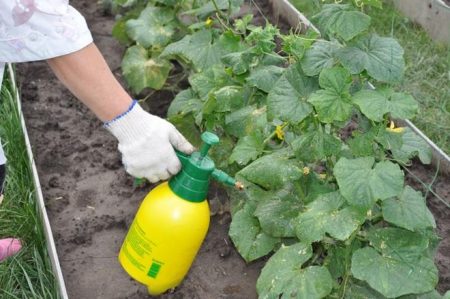 From the middle of summer, aphids appear on the beds with cucumbers, feeding on the juice of the plant. As a result, the leaves curl and dry, the ovaries fall off.
From the middle of summer, aphids appear on the beds with cucumbers, feeding on the juice of the plant. As a result, the leaves curl and dry, the ovaries fall off.
Control measures:
- Spraying bushes with infusions of onion peel, garlic with the addition of laundry soap. On a bucket of warm water take 100-150 grams of husk or 40-50 grams of chopped garlic cloves. Insist for several hours, add shavings or liquid soap, stir, leave for a day, then process the leaves and stems.
- Processing infusion of wood ash. They take a liter of ash per ten liters of water, insist, also add shavings of laundry soap, spray cucumbers.
- Infusion of tobacco dust. It will take 200 grams of tobacco, a bucket of warm water, soap shavings. All components are mixed, insisted for 5-6 hours, then planted.
Aphids are spread by aphids, so at the same time you need to fight with two types of insects.
Treatment of cucumber bushes with the Actellik preparation saves from the spider mite. From folk remedies, infusions of celandine, dandelion, horse sorrel help. They put grass in a bucket (about 300-400 grams), pour warm water, insist and then process the beds with cucumbers.
Picking a crop
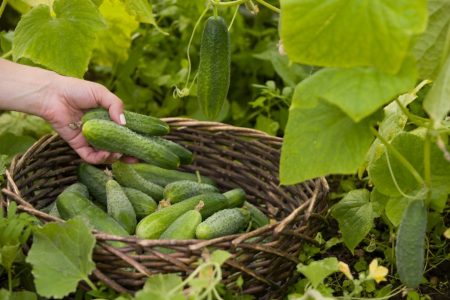 The long-awaited moment for gardeners is harvesting, but here you must follow certain rules.
The long-awaited moment for gardeners is harvesting, but here you must follow certain rules.
- Cucumbers at the peak of fruiting are harvested every day or every other day.This increases the number of new ovaries, Zelentsy do not outgrow, do not oversaturated.
- Remove all fruits, including damaged ones.
- The best time to gather Zelents is in the early morning. During this period, they are juicier, since the pulp contains more water.
- When harvesting, the whips are carefully shifted, trying not to break the shoots. Remove damaged, yellow, dried stems.
- Zelentsy on the bushes on the trellis ripen faster, so they are collected every day.
Useful tips for increasing the yield of cucumbers
Summer residents have accumulated a lot of "secrets" to increase the number of cucumbers in the beds, and are not limited to only one formation of bushes or top dressing.
We offer a number of useful tips:
- You can increase productivity by scaring cucumbers. At the beginning of flowering, watering of plants is temporarily stopped, creating a stressful situation for cucumbers. In response, the plants begin to intensively form the ovaries and greenery.
- Planting on ridges of different varieties and hybrids, which improves pollination processes, and as a result, the yield increases.
- Attraction to the site for better pollination of cucumbers of bees, for which they place plates with sweet syrup, plant honey plants near the cucumbers.
- Processing of cucumbers during flowering with stimulants Zircon, Ovary, Epin.
- Planting next to the beds of cucumbers celery, cabbage, peas. These crops have a beneficial effect on the growth of cucumbers, which ultimately contributes to high yields.
- Watering plantings with the addition of apple cider vinegar. On a barrel of 200 liters it is enough to pour 1.5-2 cups of the product, mix and water the cucumbers.
Proper care and care are the main conditions for obtaining a crop of cucumbers from the garden. Observing agricultural technology, protecting plants from infections and pests in time, you will definitely get delicious greenery and make sure that harvesting with buckets is not fantastic.

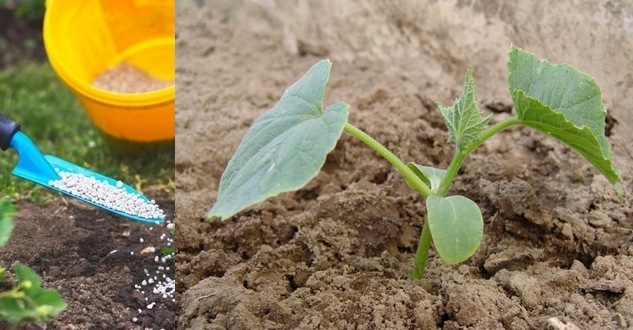
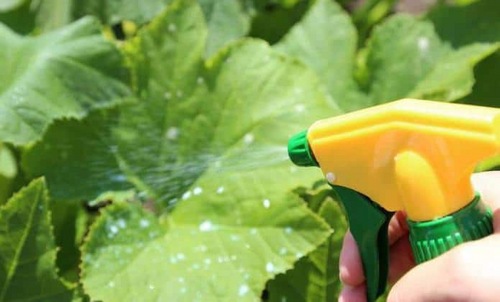
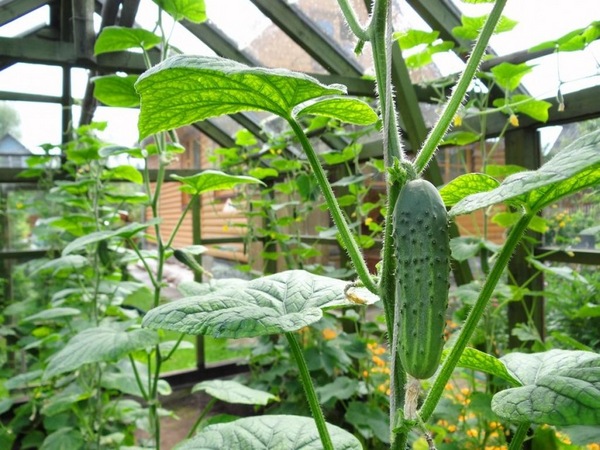
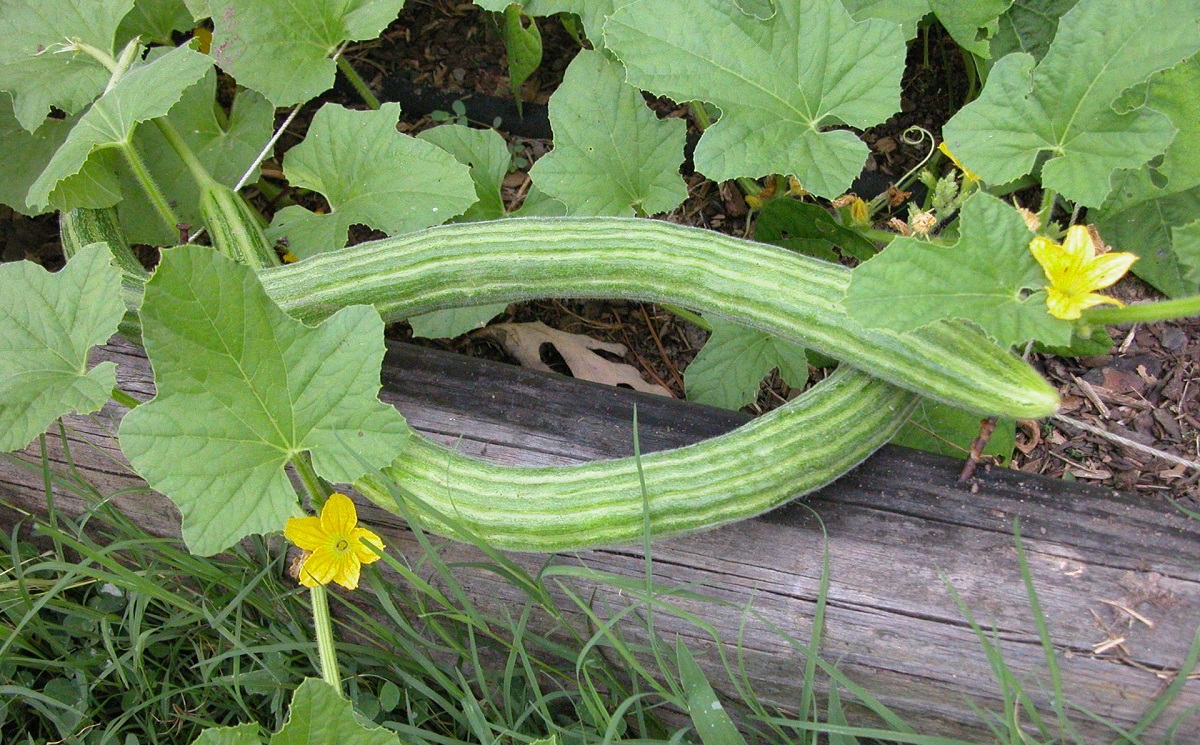 Armenian cucumber with melon flavor: description and characteristics, reviews
Armenian cucumber with melon flavor: description and characteristics, reviews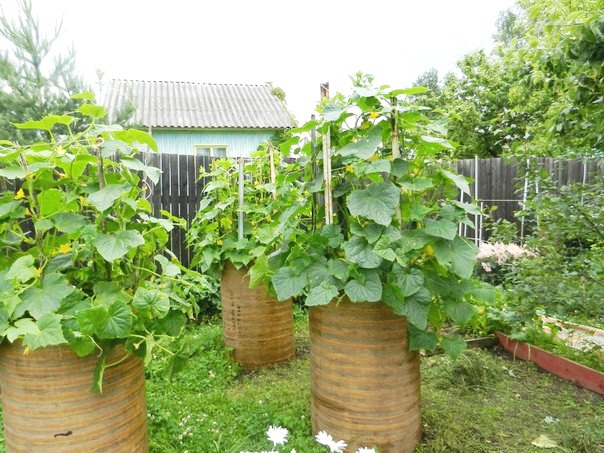 Do-it-yourself vertical beds for cucumbers: schemes, photos
Do-it-yourself vertical beds for cucumbers: schemes, photos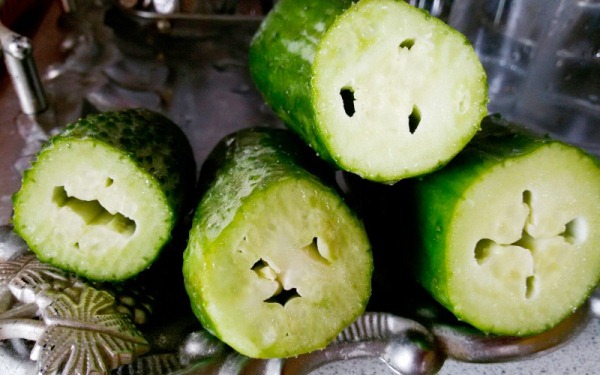 Hollow cucumbers: reasons for the appearance of hollow, what to do
Hollow cucumbers: reasons for the appearance of hollow, what to do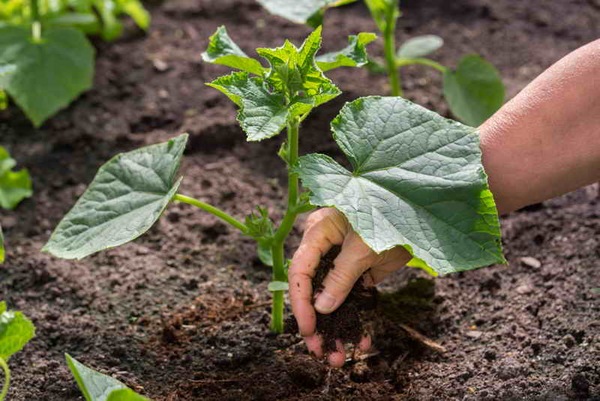 Which manure is best for cucumbers: application, how to breed
Which manure is best for cucumbers: application, how to breed